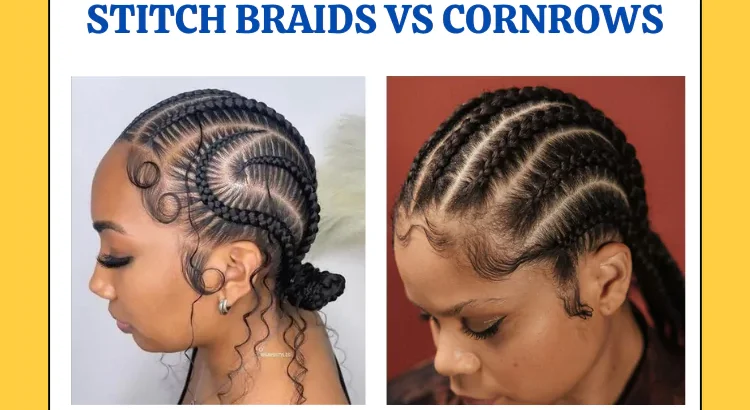Stitch braids and cornrows are two popular hairstyles known for their beauty and practicality. This guide compares stitch braids and cornrows, focusing on their unique qualities, cultural importance, and upkeep. Whether you’re new to braiding or want to master these styles, this article has all the details you need.
Stitch braids and cornrows have different techniques, looks, and care needs. We’ll cover how to make each style, their advantages, and what to consider based on your hair and lifestyle. Learn the steps to get both styles and how to keep them looking great for weeks.
Introduction to Stitch Braids and Cornrows
Stitch braids and cornrows are two popular protective styles. They have different techniques and looks. Knowing cornrows vs stitch braids helps you choose based on your hair goals and style.
What are Stitch Braids?
Stitch braids make a textured pattern by weaving strands into braids. They add hair extensions bit by bit. This method adds volume and creates a “stitched” look, perfect for modern designs.
They’ve become popular in recent years. They’re great for those who want a trendy, easy-to-maintain style.
What are Cornrows?
Cornrows come from West African traditions. They are tightly braided close to the scalp. These braids form geometric or straight patterns.
They are known for their cultural significance and durability. Cornrows protect natural hair and add timeless elegance.
Key Differences Between the Two Styles
- Structure: Stitch braids rise away from the scalp; cornrows lie flat.
- Maintenance: Stitch braids last 4–6 weeks; cornrows can last 6–8 weeks with proper care.
- Installation Time: Stitch braids take 4–6 hours; cornrows require 2–4 hours.
- Appearance: Stitch braids emphasize texture and volume; cornrows focus on precision and cultural expression.
Choosing between cornrows vs stitch braids depends on your style, hair type, and maintenance needs. Both protect your hair but serve different styles and traditions.
Advantages of Stitch Braids
Stitch braids vs cornrows men is a topic of debate. But, their unique benefits stand out. They mix bold style with practicality, giving a modern twist to traditional hairstyles.
Aesthetic Appeal
Stitch braids offer a textured look with geometric patterns. Men can choose styles that highlight their facial features. Whether it’s clean lines for a sharp look or detailed designs for a statement, these braids work for any occasion.
Versatility in Styling
- Customizable thickness and color options allow for bold contrasts or natural tones.
- Patterns range from simple grids to complex braided grids or honeycomb motifs.
- Easily paired with fades or undercut designs for added creativity.
Men can easily switch between professional and vibrant styles. This is all without changing their haircut.
Longevity and Maintenance
Stitch braids last 4–6 weeks with the right care. Here are some tips:
- Wash hair weekly with a sulfate-free shampoo.
- Apply leave-in conditioner to keep hair moist between washes.
- Sleep on a satin pillowcase to reduce hair friction and keep braids intact.
They need less touch-up compared to cornrows, perfect for busy lives. Their tight structure also holds up during workouts or daily activities.
Advantages of Cornrows
Cornrows are a timeless choice for men looking for style and practicality. They differ from stitch braids, which offer a sleek modern look. Cornrows bring unique benefits rooted in tradition and functionality. They are a great addition to men’s grooming routines.
Cultural Significance
Cornrows have deep cultural significance in many African communities. They symbolize heritage and identity. In places like Ethiopia, Ghana, and Senegal, these braids have been worn for centuries.
Today, many men wear cornrows to honor their roots and follow global fashion trends. Stylists suggest choosing patterns that reflect personal or cultural meanings. This enhances their significance.
Easy Maintenance
Cornrows require minimal upkeep. Key steps include:
- Washing every 2-3 weeks with sulfate-free shampoo
- Applying leave-in conditioner weekly
- Loosening and tightening rows every 4-5 days
These routines ensure longevity and comfort. Cornrows are perfect for active lifestyles. Unlike stitch braids, they don’t need daily styling.
Protection for Natural Hair
Cornrows protect natural hair from breakage. Benefits include:
- Minimizes split ends by securing strands
- Prevents environmental damage from dust or humidity
- Encourages natural hair growth by limiting friction
During growth phases, cornrows keep hair organized and protected. Unlike stitch braids, their tight structure works well for coarser textures. They maintain neatness during length transitions.
Step-by-Step Guide: Creating Stitch Braids
Stitch braids for men need precision to get their unique look. They are different from cornrows because they add volume by weaving in extra hair. Follow these steps for a professional look.
Preparation and Tools Needed
Start with clean, moisturized hair and use a leave-in conditioner. You’ll need a wide-tooth comb, rat-tail comb, and small clips. Men with shorter hair should use a Denman brush to smooth strands before braiding. Edge control gel helps secure sections, and hair extensions can add length where needed.
Sectioning the Hair
- Part hair into vertical sections starting from the hairline, leaving edges defined with a rattail comb.
- For shorter hair, create narrower sections (1-1.5 inches wide) to maintain structure.
- Clip sections not in use. Cornrows use horizontal partings for straight lines, while stitch braids allow for curved or geometric patterns.
The Stitching Technique
Begin at the nape or temples. Take a 1-inch base section and divide into three strands. Pull a small amount of hair from the scalp into the first two strands, then cross them over the third. Repeat, adding hair each time to build volume. Tighten gently to avoid breakage. Cornrows skip this addition, instead keeping the same thickness throughout. For shorter hair, use smaller additions to prevent gaps.
Finish by securing ends with a clear elastic. Style with serum to reduce frizz. Unlike cornrows’ tight, flat appearance, stitch braids show visible ridges when done correctly. Practice on a small section first to master tension control.
Step-by-Step Guide: Creating Cornrows
Cornrows are a classic hairstyle with deep roots in culture. They offer sleek, defined patterns, unlike the tighter loops of stitch braids. Follow this guide to learn how to do them, noting the differences between stitch braids and cornrows at each step.
Preparing Your Hair
Begin with clean, detangled hair using a wide-tooth comb. Apply a leave-in conditioner or oil to reduce friction. Secure loose strands with clips and use a fine-tooth comb to outline sections. You’ll need:
- Fine-tooth comb
- Rat-tail comb
- Small hair elastics
- Edge-control gel
Cornrows need a smoother base for straight, sharp lines, unlike stitch braids.
Sectioning and Grabbing Hair
Divide hair into even rows using a parting comb. For straight cornrows, sections should be 1/4 to 1/2 inch wide. Use a marker (like a ruler or a small brush) to ensure symmetry. When grabbing hair:
- Hold the section close to the scalp with one hand.
- Use the other hand to braid tightly, keeping strands neat.
Cornrow sections are narrower and follow geometric patterns, unlike stitch braids which allow for wider, looped sections.
Braiding Technique and Style Options
Use an underhand braid (twist strands downward), pulling each new hair section from the scalp to lock it into place. Keep even tension for a clean finish. Try styles like:
- Zigzag or curved patterns
- Feed-in braids for added length
- Box braids combined with cornrows
Cornrows need consistent pressure for a flat, tight look, unlike stitch braids which use an overhand technique for a raised, looped look. Try diamond grids or temple-to-temple rows for unique results.
Conclusion: Choosing Between Stitch Braids and Cornrows
When deciding between cornrows vs stitch braids, think about what you need. Both styles have their own perks, like cultural value and styling options. Knowing these differences helps you choose what’s best for you.
Personal Preference Considerations
Stitch braids give your hair volume and texture, making it stand out. They’re perfect for those who like modern looks. Cornrows, on the other hand, are sleek and flat, great for classic styles. Think about your face shape and style preferences when choosing.
Hair Type and Lifestyle Factors
What your hair is like and how you live also matters. Stitch braids are good for thicker hair and layers. Cornrows are better for tighter curls or shorter hair. If you’re always on the move, cornrows might be better because they stay in place well.
Final Thoughts on Style Selection
Both styles protect your hair and let you express yourself. Look for braiders who know cornrows vs stitch braids well to avoid damage. Keeping your hair moisturized and avoiding tight braids is important for its health. Try both styles to see which one you like more.
Frequently Ask Questions
Stitch braids have a textured look from adding hair gradually. This creates a three-dimensional effect. Cornrows, on the other hand, are braided flat against the scalp. They often look sleeker.
Both styles work for men, depending on what they like and their hair type. Stitch braids offer a bold look that suits various hair lengths and textures. Cornrows are great for those who want a style that’s easy to maintain and connects to their heritage.
Stitch braids can last 4-6 weeks with the right care. Cornrows can also last up to 6 weeks, depending on your hair and how well you take care of it. Keeping both styles clean and moisturized is key to their longevity.
Stitch braids need careful washing and moisturizing to keep their texture. Cornrows are easier to maintain, making them perfect for busy people. Both styles should be handled gently and protected at night.
Yes, you can add hair extensions to both styles for extra length, volume, or color. Stitch braids allow for more detailed patterns, while cornrows are simpler to integrate extensions into.
The basic techniques for stitch braids and cornrows are the same for everyone. Men might need to adjust for shorter hair or texture. Stitch braids can add unique patterns to masculine hairstyles. Cornrows can be styled in many ways to fit different hair types.
Stitch braids are more versatile because they can be styled in many ways, including different patterns and colors. Cornrows are also versatile but tend to have a more uniform look. They’re good for simpler styles but can also be made into detailed designs.
Your choice depends on what you like, your hair type, and your lifestyle. Think about the look you want, how much time you have for maintenance, and whether you prefer a textured or flat style.

Hi there! I’m M.Afzal, a passionate and experienced hair stylist with a love for creating unique and trendsetting looks. With years of expertise in the industry, I’m dedicated to sharing top-notch advice and inspiring ideas to elevate your hairstyle game. Join me on this journey of beauty and self-expression as we explore the captivating world of peekaboo braids and much more!

